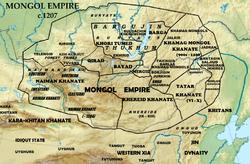
Back المركيت Arabic Merkitlər Azerbaijani Меркити Bulgarian Markit Catalan مێرکیت CKB Merkité Czech Merkiten German Merkit Spanish مرکیت Persian Merkiitit Finnish
This article needs additional citations for verification. (December 2011) |
Merkit Three Mergids | |||||||||||
|---|---|---|---|---|---|---|---|---|---|---|---|
| 11th century–1200 | |||||||||||
 Mongol Empire c.1207 | |||||||||||
| Status | nomadic confederacy | ||||||||||
| Capital | Not specified | ||||||||||
| Religion | Shamanism | ||||||||||
| Government | Elective monarchy | ||||||||||
| Khan | |||||||||||
| Historical era | Post-classical Central Asia | ||||||||||
• Established | 11th century | ||||||||||
• Disestablished | 1200 | ||||||||||
| |||||||||||
| Today part of | Mongolia Russia (Buryatia) | ||||||||||
| History of Mongolia |
|---|
 |
The Merkit (literally "skillful/wise ones"; Mongolian: ᠮᠡᠷᠬᠢᠳ ; Мэргид, romanized: Mergid; simplified Chinese: 蔑儿乞; traditional Chinese: 蔑兒乞; pinyin: Miè'érqǐ) was one of the five major tribal confederations (khanlig) of probably Mongol[1][2][3][4] or Turkic origin[5][6][note 1] in the 12th century Mongolian Plateau.
The Merkits lived in the basins of the Selenga and lower Orkhon River (modern south Buryatia and Selenge Province).[8] After a struggle of over 20 years, they were defeated in 1200 by Genghis Khan and were incorporated into the Mongol Empire.
- ^ History of the Mongolian People's Republic. — Nauka Pub. House, Central Dept. of Oriental Literature, 1973. — p. 99.
- ^ Jeffrey Tayler. Murderers in Mausoleums: Riding the Back Roads of Empire Between Moscow and Beijing. — Houghton Mifflin Harcourt, 2009. — p. 1. — ISBN 9780547523828.
- ^ Bertold Spuler. The Muslim world: a historical survey. — Brill Archive, 1969. — p. 118.
- ^ Elza-Bair Mataskovna Gouchinova. The Kalmyks. — Routledge, 2013. — p. 10. — ISBN 9781135778873.
- ^ Soucek, Svat. A History of Inner Asia. — Cambridge University Press, 2000. — p. 104. — ISBN 978-0521657044.
- ^ Гурулёв С. А. Реки Байкала: Происхождение названий. – Иркутск: Восточно-Сибирское книжное издательство, 1989 – 122 с. ISBN 5-7424-0286-4
- ^ Christopher P. Atwood – Encyclopedia of Mongolia and the Mongol Empire ISBN 9780816046713, Facts on File, Inc. 2004.
- ^ History of Mongolia, Volume II, 2003
Cite error: There are <ref group=note> tags on this page, but the references will not show without a {{reflist|group=note}} template (see the help page).